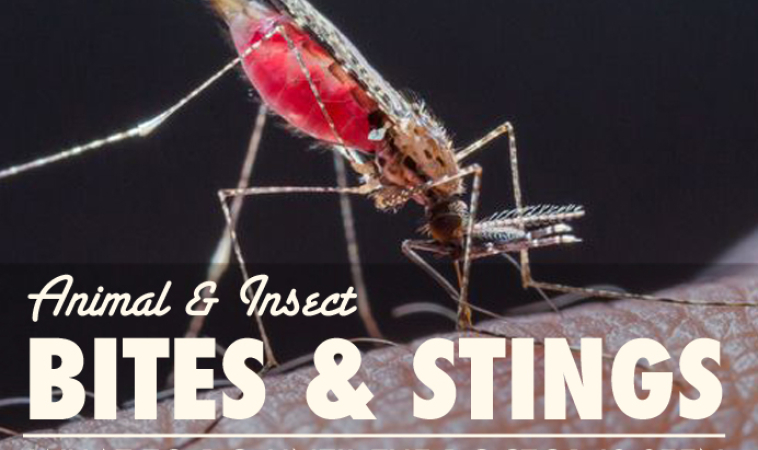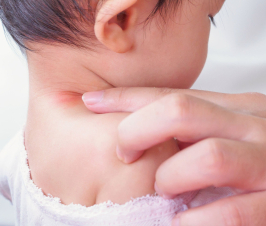The bites and stings of insects or animals more commonly occur in the spring, summer and early fall due to the larger number of insects which are present and the increase in out of door activities. Bee stings are probably the most common bites encountered and can be problematic in individuals susceptible to bee venom. In warmer climates and in buildings during the winter months, insect bites may occur, especially those of spiders. In the Southwest United States, scorpion bites are common resulting in localized pain and swelling. Snakebites are less common but certainly warrant prompt attention. In most cases with an insect bite, the person will experience faintness, weakness and mild nausea, while the area bitten becomes red, painful and swollen. This condition usually abates in a few days.
If the bite becomes infected, a red streak may begin to travel from the site as the infection spreads through the lymphatics. This is the beginning of blood poisoning, and if not responding to homeopathic or other home therapy treatment, the person needs to be seen by a physician.
In some cases, especially with spider bites, the lesion will begin to break down after a few days due to the poisons which have been left in the skin. Necrotic skin is a breeding ground for bacteria that can lead to blood poisoning if left unchecked. This is always accompanied by a fever.
In some cases, the person may react immediately to the insect bite by going into anaphylactic shock. This is a life-threatening condition which requires emergency treatment.
What to do until the doctor is seen
- Determine the type of vector if possible. The treatment or referral to the emergency room will depend upon the type of vector.
- Reassure and calm the patient if they are upset or hysterical. This will help decrease the spread of any venom or substance injected.
- Check vital signs, temperature, pulse and respiration rate. If possible, obtain a blood pressure as well.
- Check for the development of hives, itching or swelling. Bee and wasp stings cause considerable pain, swelling and itching and can turn into an anaphylactic reaction quickly.
- Apply the appropriate treatment for the bite encountered.
- Monitor frequently for the first few hours in case of a delayed reaction.
- In the absence of a response to your homeopathic prescription or other therapy, consider using aqueous epinephrine 1:1000 up to 0.5 ml intramuscularly to get them over the initial reaction. This can be given by an Epipen.
- Treatment for shock and hypotension may also be needed in addition to the other therapies. Placing the patient in the Trendelenburg position (head lying lower than their torso) will help restore blood flow to the head.
Snake bites – patient should be kept still and warm while being reassured during transport to the nearest emergency room for treatment. Loosely immobilize the injured extremity in a functional position below the heart. Remove all rings watches and other jewelry in anticipation of swelling. Tourniquets, incision, suction, and cold packs are contraindicated.
The child should be carried or transported via wheel chair as activity stimulates circulation and spreads the poison.
Spider bites – ice and check vital signs frequently. Monitor for at least 12 hours as these bites tend to become more necrotic than bee stings. This can cause tissue damage that may become secondarily infected.
Tick bites – ticks attach themselves to humans to ingest blood while in the process leaving behind a variety of infective agents. The tick can be asphyxiated by coating it with a heavy ointment so that it can be removed more easily. It is important to try and get the probiscus (pinchers) out completely and to retain the tick for identification.
Animal bites – bites of animals will vary from scratches to puncture wounds, to tearing of flesh. Most puncture wounds and abrasions can be treated by cleansing with soap and water. A tetanus shot may be in order if not up to date (within the last 5 years). Wounds with a tearing of flesh may need to be sutured. Animal bites are generally less likely to cause an infection than human bites because animal teeth are spaced farther apart and harbor fewer bacteria than humans.
Some immediate home treatments that can be administered are:
- Ice the bite to decrease swelling.
- Depending upon the bite, use of homeopathic Ledum 30C for puncture wounds, Arnica 30C for cuts, contusions and bruises, Calendula 30C for raw open wounds, and Staphysagria 30C for lacerations. All of these can be administered every 15 minutes until the pain and swelling has diminished.
- Clay, potato or Epsom Salts poultice to reduce swelling and pain while removing toxins.
This article is an excerpt from the Natural Medicine Pediatric Home Health Advisor

















